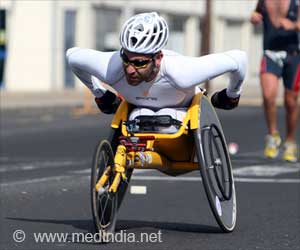- Neuropathic pain in athletes with spinal cord injury is difficult to diagnose and manage
- Accurate pain assessment is crucial for effective treatment and performance
- A holistic approach, including medical, physical, and psychological support, is essential
As the Paris 2024 Paralympic Games approach, the focus on the intense training and sacrifices of high-performance athletes, particularly those with disabilities, becomes increasingly prominent. For Paralympians and high-performance athletes with spinal cord injuries (SCI), chronic pain assessment is crucial to their training and competitive readiness (1✔ ✔Trusted Source
Defining chronic pain for high-performance athletes with disabilities
).
Recent research from UBC Okanagan sheds light on the complexities of chronic pain, particularly neuropathic pain, in this unique athlete population.
The research, published in BMJ Open Sport & Exercise Medicine, is one of the first to provide a comprehensive description of how neuropathic pain affects athletes with SCI and the challenges they face in identifying and communicating their pain.
Advertisement
Chronic Pain and Its Challenges for Athletes with Disabilities
Chronic pain, a persistent discomfort that lasts for at least three months, can significantly impact the lives of individuals. For athletes with disabilities, especially those with spinal cord injuries (SCI), the challenges posed by chronic pain are even more pronounced. The constant battle against pain can hinder training, limit performance, and affect overall well-being.
Chronic pain in athletes with SCI is often a complex interplay of physical, psychological, and emotional factors. The damage to the nervous system caused by SCI can result in neuropathic pain, a type of pain that arises from the nervous system itself. This can lead to sensations such as burning, tingling, or shooting pain, which can be particularly debilitating for athletes.
In addition to neuropathic pain, athletes with SCI may also experience other types of chronic pain, such as musculoskeletal pain or phantom limb pain. These types of pain can further complicate the athlete’s experience and make it difficult to manage their overall pain.
Advertisement
The Importance of Accurate Pain Assessment
Accurate pain assessment is crucial for athletes with SCI to effectively manage their chronic pain. By understanding the nature, intensity, and location of the pain, healthcare professionals can develop personalized treatment plans that address the specific needs of each athlete.
One of the challenges in assessing chronic pain in athletes with SCI is that they may be hesitant to report their pain for fear of being seen as weak or unable to perform. It is important for healthcare professionals to create a safe and supportive environment where athletes feel comfortable discussing their pain experiences.
Advertisement
Supporting Athletes with Spinal Cord Injuries
Supporting athletes with SCI requires a holistic approach that addresses both the physical and psychological aspects of chronic pain. This may involve a combination of medical interventions, physical therapy, psychological counseling, and lifestyle modifications.
Medical Interventions: Medications, such as pain relievers, antidepressants, or anticonvulsants, can be used to manage chronic pain in athletes with SCI.
Physical Therapy: Physical therapy can help athletes improve their strength, flexibility, and range of motion, which can reduce pain and improve overall function.
Psychological Counseling: Chronic pain can have a significant impact on mental health. Psychological counseling can help athletes cope with the emotional challenges of living with chronic pain.
Lifestyle Modifications: Lifestyle changes, such as regular exercise, stress management techniques, and a healthy diet, can also help manage chronic pain.
By working together with healthcare professionals, athletes with SCI can develop effective strategies to manage their chronic pain and continue to pursue their athletic goals.
Effective management of neuropathic pain is not only vital for alleviating discomfort but also for facilitating continued sport participation and promoting the overall wellbeing of athletes with SCI. As we cheer for our Paralympians, let’s keep in mind the invisible struggles they endure and advocate for better pain management practices to support their journey to success.
Reference:
- Defining chronic pain for high-performance athletes with disabilities – (https://news.ok.ubc.ca/2024/08/27/defining-chronic-pain-for-high-performance-athletes-with-disabilities/)
Source-Medindia



